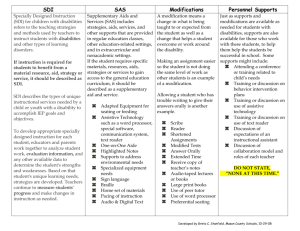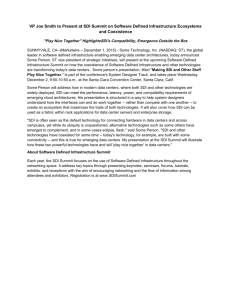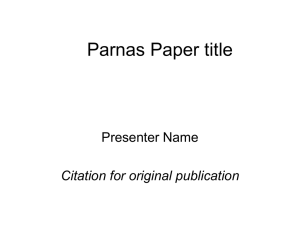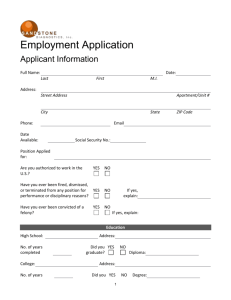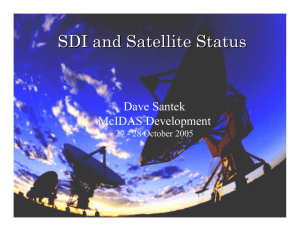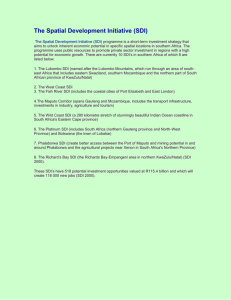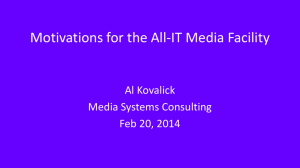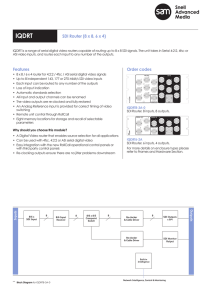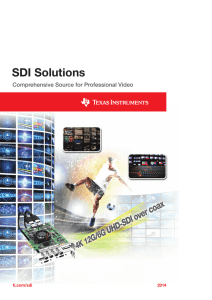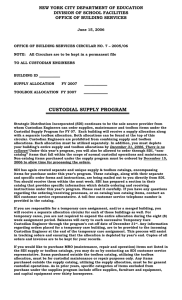National Spatial Data Infrastructure (NSDI-India)
advertisement
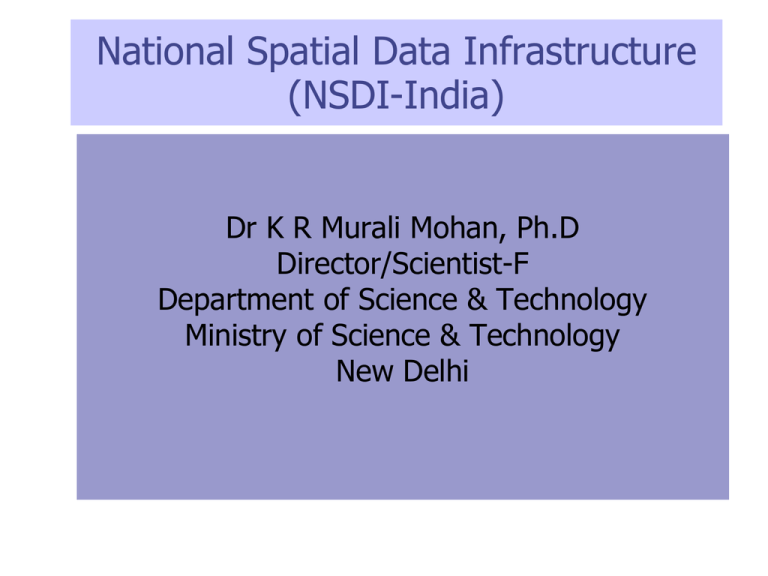
National Spatial Data Infrastructure (NSDI-India) Dr K R Murali Mohan, Ph.D Director/Scientist-F Department of Science & Technology Ministry of Science & Technology New Delhi What is a Spatial Data Infrastructure (SDI)? “It is an INFRASTRUCTURE that provides a basis for spatial data discovery, evaluation and application for Macro & micro level planners, implementers, users and providers within all levels of government, the commercial sector, the non-profit sector, academia and by citizens in general.” --The SDI Cookbook Who needs access to coordinated geographic information? Land Records Adjudication Disaster Management Transportation Management Water, gas & electric planning Public Protection Defense Natural Resource Management Telecommunications Infrastructure Economic Development Civic Entrepreneurs Local Bodies Components of a Spatial Data Infrastructure (SDI) Policies & Institutional Arrangements (governance, data privacy & security, data sharing, cost recovery) People (training, professional development, cooperation, outreach) Data (digital base map, thematic, statistical, place names) Technology (hardware, software, networks, databases, technical implementation plans) Why to build an SDI? Build data once and use it many times for many applications Integrate distributed providers of data: Cooperative governance “Location-based management” Share costs of data creation and maintenance Support sustainable economic, social, and environmental development Best practices Treat data as strategic, capital assets and public goods Collaborate and Coordinate Align roles, responsibilities and resources for data stewardship Organize Effective and Efficient Production and Stewardship of Data Pool and Leverage Investments The outcomes of an NSDI The participant members (contributors and users) are known and can interact Core and specialized map and data services are easily discoverable and accessible Decision-makers and analysts have ready access to the right geo-information for input to analytical and visual models – indicators, models, trends, patterns Creating the motivation Development of an SDI should be a voluntary and have long-term vision Government roles may require both incentives and directives Commercial and non-commercial participants should find SDI appealing as a market The correct solution for NSDI must be defined by the community Partnerships extend our capabilities Partnerships Discovery Access Processing Services Metadata Framework GEOdata Standards Roles of standards bodies Software interfaces (Implementation Specifications) OpenGIS Consortium Other NSDIs Endorsed practices and specifications NSDI ISO TC 211 Foundations for implementation. (Abstract standards) National Standards Content standards, Authority for data SDI Applications Earthquakes Floods Landslides Cloud Bursts Tsunami Avalanche etc Pollution Water Quality Ground water depletion Vector borne Diseases Hunger, Poverty and malnutrition Crime Sex ratio Govt. of India Role in SDI development Advanced Internet infrastructure design, establishing the backbone IT Expertise GOI has understood the importance of SDI and implementation Collaborations & Partners Survey of India MOEF Department of Space India Meteorological Dept Geological Survey of CWC, CGWB India Forest Survey of MoES, MoUD, MoRD, India MoLR, NIC, Census of India NBSSLUP NATMO, CPCB MoD NCAER MHA NDMA NSDI Clearinghouse Supports uniform, distributed search through a single user interface to all domestic metadata collections to find data and maps A free advertising mechanism to provide world access to your holdings under the principle of “truth-in-labeling” Search for spatial data through fields and fulltext in the metadata and categorical browsing Links through to full data access and online web mapping services, where available NSDI-India Management Structure NSDI-Steering Committee NSDI-Executive Committee NSDI-Nodal Agencies & Nodal Officers Sectoral Committees NSDI-India Secretariat CEO and officers NSDI-India Standards Framework OGC BIS Meta Data Standards, content standards developed and working on unified data model etc Service Framework WMS WFS WMTS WCS Security (authorisation and Authentication) Legal Framework Value Addition IPR Patents Non-repudiation Accuracies Ownership Policy Framework National Data Sharing and Accessibility Policy (NDSAP) VIGIL State SDI’s Outreach Training and capacity building NIGTR, Center for Excellences (IIT’s) Training for Asia Pacific countries Open mind approach to share the experiences and hand holding Future directions-Convergence:GeoICT A basic building block for E-Government Shall focus on the use and re-use of data and services between government (G2G) and the citizen (G2C) Involves all sectors (Central, state, local government, academia, commercial) Dept. of Science & Technology NRDMS & NSDI Thanks
